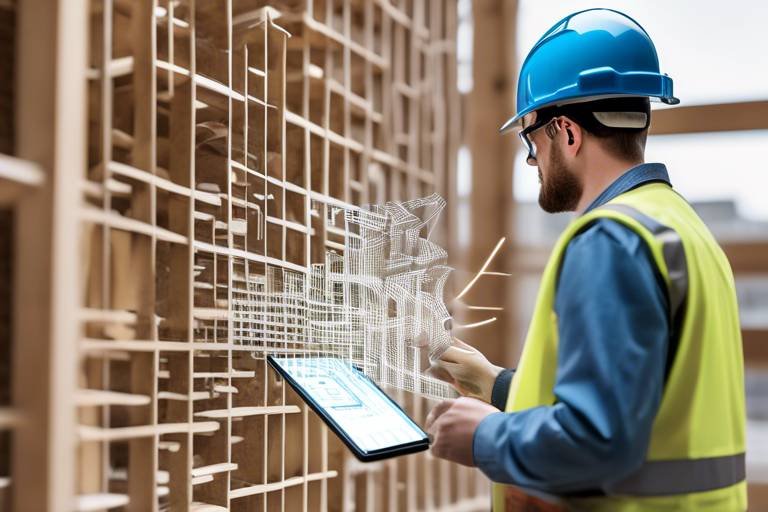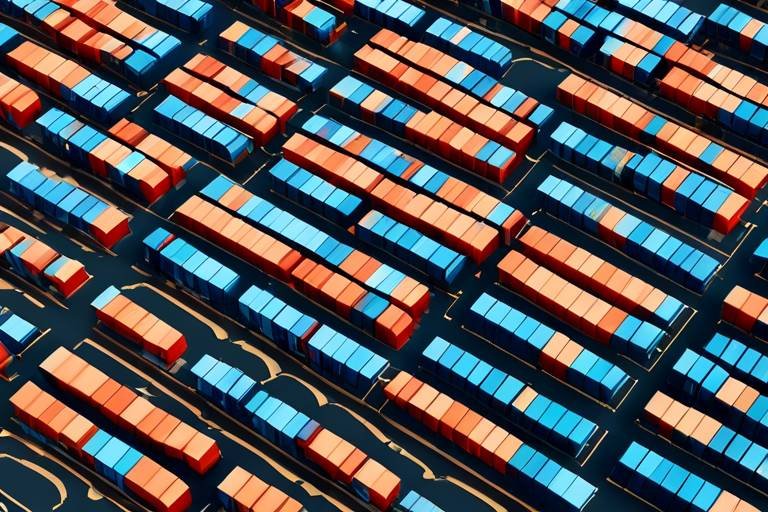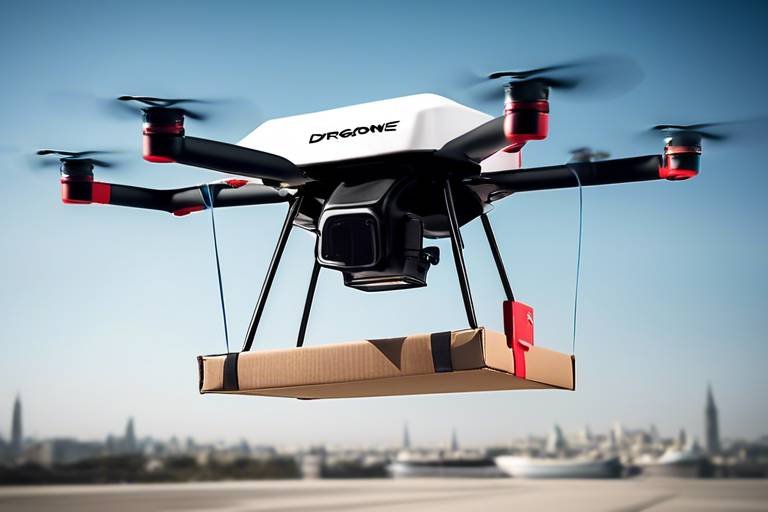The Role of AI in Enhancing Transportation Safety
In today's fast-paced world, the intersection of technology and safety has never been more crucial, especially in transportation. With the rise of artificial intelligence (AI), we are witnessing an incredible transformation in how we approach safety on the roads. Imagine a world where accidents are significantly reduced, traffic flows smoothly, and vehicles can communicate with each other to prevent collisions. This isn't just a futuristic dream; it's becoming a reality thanks to AI. By leveraging innovative technologies, predictive analytics, and enhanced decision-making processes, AI is reshaping the landscape of transportation safety.
At the heart of this revolution lies the ability of AI to analyze vast amounts of data in real-time. Think of it as having a super-intelligent co-pilot who can foresee potential hazards and take action before a situation escalates. This capability is not only enhancing the safety of individual drivers but is also contributing to the overall safety standards in transportation. As we delve deeper into the various applications of AI in this field, you'll discover how these advancements are not just improving safety but are also paving the way for a smarter, more efficient transportation system.
From collision avoidance systems that alert drivers to potential dangers, to predictive maintenance technologies that ensure vehicles are always in top condition, AI is at the forefront of creating safer roads. Furthermore, with the integration of AI in fleet management, transportation companies can monitor driver behavior and vehicle performance like never before. This comprehensive approach to safety is not just reactive but proactive, addressing issues before they become critical.
As we explore the various dimensions of AI's role in transportation safety, it's essential to recognize that this technology is not just a tool; it's a game-changer that is redefining how we think about safety on the roads. The future of transportation is bright, and AI is leading the way, ensuring that every journey is a safer one.
- How does AI improve collision avoidance?
AI analyzes real-time data from various sensors to detect potential hazards, allowing vehicles to take preventive actions to avoid collisions. - What is predictive maintenance?
Predictive maintenance uses AI to analyze vehicle performance data, predicting mechanical failures before they occur to enhance safety and reduce downtime. - Can AI help with traffic management?
Yes, AI algorithms optimize traffic flow by analyzing patterns and adjusting signal timings, which helps reduce congestion and the associated risks of accidents. - What role do autonomous vehicles play in safety?
Autonomous vehicles use AI to eliminate human error, which is a leading cause of road accidents, thereby enhancing overall safety.

AI-Powered Collision Avoidance Systems
In the realm of transportation safety, are revolutionizing how we think about vehicle safety. Imagine a world where your car can "see" potential dangers before you do. These systems utilize advanced AI algorithms to analyze a plethora of data in real-time, allowing vehicles to detect potential hazards and take preventive actions. This technology acts like a vigilant co-pilot, constantly scanning the environment to ensure your safety.
At the heart of these systems is a complex network of sensors, cameras, and radar that work together to create a comprehensive picture of the vehicle's surroundings. When a potential collision is detected, the system can automatically apply the brakes, adjust steering, or even issue warnings to the driver. This proactive approach significantly reduces the likelihood of accidents on the road, making it a game-changer in the field of transportation safety.
To illustrate the effectiveness of AI-powered collision avoidance systems, consider the following statistics:
| Year | Accident Reduction (%) |
|---|---|
| 2018 | 15% |
| 2019 | 25% |
| 2020 | 35% |
As you can see, the implementation of these systems has led to a remarkable decline in accidents over the years. But how does this technology work? It primarily relies on machine learning to improve its accuracy. The more data the system processes, the better it becomes at predicting potential hazards. This continuous learning cycle allows for real-time adjustments and improvements, ensuring that each journey is safer than the last.
Moreover, these systems are not just limited to individual vehicles. They can be integrated into larger transportation networks, allowing for enhanced communication between vehicles and infrastructure. For instance, traffic signals equipped with AI can communicate with nearby vehicles to provide warnings about upcoming hazards, creating a more cohesive and safe driving environment.
In summary, AI-powered collision avoidance systems are a crucial step forward in enhancing transportation safety. By leveraging real-time data and advanced algorithms, these systems not only help prevent accidents but also foster a culture of safety on the roads. As we continue to embrace this technology, we can look forward to a future where the roads are safer for everyone.

Predictive Maintenance for Vehicles
Imagine driving a car that knows when it's about to break down before you even notice a problem. Sounds futuristic, right? Well, welcome to the world of predictive maintenance powered by artificial intelligence (AI). This innovative technology is revolutionizing how we maintain vehicles, ensuring that potential issues are identified and addressed before they become serious problems. By analyzing data from various sensors and systems within a vehicle, AI can predict when components are likely to fail, allowing for timely interventions that not only enhance safety but also optimize vehicle performance.
In traditional maintenance practices, vehicles are often serviced based on time intervals or mileage, which can lead to unnecessary repairs or, worse, unexpected breakdowns. With predictive maintenance, however, the focus shifts to data-driven insights. AI algorithms sift through vast amounts of data collected from a vehicle's operation, including engine performance, braking systems, and tire conditions, to identify patterns that may indicate wear and tear. For instance, if a vehicle's brake pads are showing signs of excessive wear based on driving habits and environmental factors, the system can alert the driver or fleet manager to schedule a maintenance check before a failure occurs.
One of the most significant advantages of predictive maintenance is its ability to reduce downtime. In the transportation industry, every minute a vehicle is out of service can lead to substantial financial losses. By proactively addressing maintenance needs, companies can keep their fleets running smoothly and safely. This not only improves the bottom line but also enhances the safety of drivers and passengers alike. After all, a well-maintained vehicle is less likely to experience mechanical failures that could lead to accidents.
Moreover, predictive maintenance contributes to a more sustainable approach to vehicle management. By ensuring that maintenance is performed only when necessary, rather than on a fixed schedule, companies can reduce waste and lower their environmental impact. This aligns with the growing trend toward sustainability in transportation, where efficiency and eco-friendliness are becoming paramount.
To illustrate the impact of predictive maintenance, consider the following table that compares traditional maintenance practices with predictive maintenance:
| Aspect | Traditional Maintenance | Predictive Maintenance |
|---|---|---|
| Maintenance Schedule | Time-based or mileage-based | Data-driven, condition-based |
| Downtime | Unpredictable | Minimized |
| Cost | Potentially higher due to unexpected repairs | Lower due to proactive management |
| Environmental Impact | Higher due to unnecessary repairs | Lower due to efficiency |
In conclusion, the integration of AI in predictive maintenance is a game-changer for the transportation industry. It not only enhances safety by preventing mechanical failures but also promotes efficiency and sustainability. As technology continues to advance, we can expect even more sophisticated predictive maintenance solutions that will further improve the safety and reliability of vehicles on our roads.
Q: What is predictive maintenance?
A: Predictive maintenance uses AI and data analytics to predict when a vehicle will require maintenance, allowing for proactive repairs.
Q: How does predictive maintenance improve safety?
A: By identifying potential mechanical failures before they occur, predictive maintenance reduces the risk of accidents caused by equipment failure.
Q: Is predictive maintenance costly?
A: While there may be initial costs associated with implementing predictive maintenance systems, they often lead to long-term savings by reducing downtime and unexpected repairs.

Data Analytics in Fleet Management
In the fast-paced world of transportation, data analytics has emerged as a game changer for fleet management. Imagine being able to predict potential issues before they occur, thereby saving time, money, and, most importantly, lives. Fleet managers are now harnessing the power of artificial intelligence (AI) to analyze vast amounts of data generated by vehicles and drivers. This technology enables them to make informed decisions that can significantly enhance safety protocols and operational efficiency.
One of the most compelling aspects of data analytics in fleet management is its ability to monitor vehicle performance in real-time. By collecting data on various parameters such as speed, fuel consumption, and engine health, fleet managers can identify trends and anomalies that might indicate a problem. For instance, if a particular vehicle consistently shows high fuel consumption, it may signal an underlying mechanical issue or inefficient driving behavior. Addressing these issues proactively not only improves safety but also reduces costs associated with repairs and downtime.
Moreover, AI-driven analytics can provide insights into driver behavior. By analyzing driving patterns, fleet managers can identify risky behaviors such as harsh braking, rapid acceleration, or excessive speeding. These insights can be used to implement targeted training programs aimed at correcting unsafe driving habits. For example, if data reveals that a driver frequently engages in harsh braking, they can be enrolled in a defensive driving course to promote safer driving practices. This not only enhances individual driver safety but also contributes to the overall safety of the fleet.
To illustrate the impact of data analytics on fleet management, consider the following table that highlights key benefits:
| Benefit | Description |
|---|---|
| Enhanced Safety | Real-time monitoring of driver behavior and vehicle performance reduces accident rates. |
| Cost Efficiency | Proactive maintenance and improved fuel efficiency lead to significant cost savings. |
| Informed Decision-Making | Data-driven insights empower fleet managers to make strategic operational decisions. |
| Regulatory Compliance | Analytics help ensure compliance with safety regulations and standards. |
In conclusion, the integration of data analytics in fleet management not only enhances safety but also optimizes operational efficiency. Fleet managers are now equipped with the tools to make data-driven decisions that can lead to safer roads and more efficient operations. As technology continues to evolve, the potential for further improvements in transportation safety is limitless, paving the way for a future where accidents are significantly reduced, and public confidence in transportation systems is bolstered.
- What is data analytics in fleet management? Data analytics in fleet management refers to the use of AI and data analysis tools to monitor and improve vehicle performance, driver behavior, and overall fleet efficiency.
- How does data analytics enhance safety? By analyzing real-time data, fleet managers can identify risky behaviors and mechanical issues, allowing for proactive measures to be taken to prevent accidents.
- Can data analytics reduce costs for transportation companies? Yes, by optimizing vehicle performance and reducing downtime through predictive maintenance, companies can achieve significant cost savings.
- What role does AI play in data analytics? AI algorithms process large datasets to identify patterns and provide actionable insights, making it easier for fleet managers to make informed decisions.

Real-Time Monitoring Solutions
In today’s fast-paced world, have emerged as a game-changer in ensuring transportation safety. Imagine a scenario where every vehicle on the road is equipped with technology that constantly watches over its condition and the behavior of its driver. This isn't just a fantasy; it's the reality brought forth by artificial intelligence (AI). By leveraging advanced sensors and AI algorithms, these systems can track a multitude of factors, from vehicle speed and tire pressure to driver fatigue and sudden braking.
One of the most fascinating aspects of real-time monitoring is its ability to provide immediate feedback. For instance, if a driver is veering off course or exhibiting signs of distraction, the system can alert them instantly. This proactive approach is akin to having a co-pilot who nudges you back on track before you even realize you’re drifting. The idea is to create an environment where safety is not just a goal but a continuous process, enhancing the overall driving experience.
Furthermore, these solutions are not limited to individual vehicles. They can be integrated into fleet management systems, allowing companies to monitor their entire fleet in real-time. This means that if a truck in a fleet is experiencing mechanical issues or if a driver is engaging in risky behavior, fleet managers can intervene swiftly. This level of oversight can drastically reduce the chances of accidents, as issues are addressed before they escalate into serious problems.
To illustrate the impact of real-time monitoring, consider the following table that highlights key features and benefits:
| Feature | Benefit |
|---|---|
| Real-time alerts | Immediate feedback to drivers for unsafe behaviors |
| Vehicle diagnostics | Proactive maintenance to prevent breakdowns |
| Driver behavior tracking | Identification and correction of risky driving habits |
| Fleet-wide monitoring | Enhanced safety protocols across all vehicles |
As we look to the future, the potential for real-time monitoring solutions to enhance transportation safety is enormous. With advancements in AI and sensor technologies, we can expect even more precise monitoring capabilities that will not only alert drivers and fleet managers but also provide valuable data for improving safety standards across the board. It's like having a safety net that continually adapts and evolves, ensuring that our roads become safer for everyone.
- What are real-time monitoring solutions?
Real-time monitoring solutions are technologies that continuously track vehicle conditions and driver behaviors to enhance safety and prevent accidents. - How do these solutions work?
They use a combination of sensors and AI algorithms to analyze data and provide immediate feedback to drivers and fleet managers. - What are the benefits of real-time monitoring?
Benefits include immediate alerts for unsafe behaviors, proactive vehicle maintenance, and improved safety protocols across fleets. - Can real-time monitoring be used for individual vehicles?
Yes, these solutions are applicable to both individual vehicles and larger fleets, making them versatile for various transportation needs.

Driver Behavior Analysis
Understanding driver behavior is crucial in the quest for safer roads, and this is where AI systems come into play. By analyzing vast amounts of data collected from vehicles, AI can pinpoint risky driving habits that might otherwise go unnoticed. Imagine having a personal coach in your car, constantly monitoring your driving and providing feedback to help you become a better driver. This is precisely what AI-driven behavior analysis accomplishes.
Through sophisticated algorithms, AI can evaluate factors such as speed, braking patterns, acceleration, and even the frequency of lane changes. For instance, if a driver tends to accelerate rapidly and brake suddenly, the system can flag this behavior as risky. This analysis is not just about identifying bad habits; it’s also about fostering a culture of safety. When drivers receive real-time feedback, they can adjust their behavior immediately, leading to a significant decrease in accidents.
Moreover, AI can categorize driver behaviors into different risk levels, allowing transportation companies to tailor their training programs effectively. For example, drivers exhibiting high-risk behaviors might undergo more intensive training sessions focused on defensive driving techniques. This personalized approach not only enhances individual driver performance but also contributes to the overall safety of the fleet. To illustrate this, consider the following table that outlines various driver behaviors and their corresponding risk levels:
| Driver Behavior | Risk Level | Recommended Action |
|---|---|---|
| Frequent Hard Braking | High | Defensive Driving Course |
| Excessive Speeding | High | Speed Management Training |
| Sudden Lane Changes | Medium | Safe Lane Change Techniques |
| Consistent Safe Driving | Low | Recognition and Rewards |
In addition to real-time feedback and training, AI-driven driver behavior analysis can also facilitate a more profound understanding of how external factors influence driving. For example, weather conditions, time of day, and traffic patterns can all affect how a driver operates their vehicle. By integrating this data, AI can help drivers make informed decisions, such as when to slow down during inclement weather or how to navigate through heavy traffic safely.
Ultimately, the goal of driver behavior analysis is not to penalize drivers but to promote a safer driving culture. As transportation companies embrace these AI technologies, they are not only enhancing safety but also fostering a sense of accountability among drivers. This dual approach—leveraging technology while encouraging personal responsibility—creates a safer environment for everyone on the road.
- How does AI analyze driver behavior?
AI analyzes driver behavior by collecting data from vehicles, such as speed, braking patterns, and lane changes, using advanced algorithms to identify risky habits. - What actions can be taken based on driver behavior analysis?
Based on the analysis, transportation companies can implement targeted training programs to help drivers improve their skills and reduce risky behaviors. - Is driver behavior analysis intrusive?
No, it is designed to enhance safety without being intrusive. The focus is on providing constructive feedback for improvement. - Can AI help in recognizing safe drivers?
Absolutely! AI can identify safe driving habits, allowing companies to reward and recognize responsible drivers.

Autonomous Vehicles and Safety Enhancements
When we think about the future of transportation, autonomous vehicles (AVs) often come to mind. These self-driving cars are not just a sci-fi fantasy; they are rapidly becoming a reality. But what makes them so special when it comes to safety enhancements? The answer lies in their ability to eliminate human error, which is a leading cause of road accidents. Imagine a world where vehicles communicate with each other and their environment, making split-second decisions that prioritize safety over everything else. This is not just a dream; it's the essence of how AI is revolutionizing transportation.
One of the most striking features of AVs is their reliance on advanced AI algorithms and an array of sensors. These vehicles are equipped with cameras, radar, and LIDAR systems that constantly monitor their surroundings. This technology enables them to detect obstacles, pedestrians, and other vehicles, allowing them to react in real-time. For instance, if a child suddenly runs onto the road, an AV can react faster than a human driver, applying brakes or steering away from danger. This capability can dramatically reduce the likelihood of accidents.
Moreover, autonomous vehicles are designed to learn from every trip they make. Through machine learning, they analyze vast amounts of data to improve their decision-making processes continuously. This means that with each journey, they become better at predicting and responding to various driving scenarios. It's akin to how a seasoned driver becomes more adept at navigating complex traffic situations over time, but with the added benefit of not being influenced by emotions or distractions.
While the technology behind AVs is impressive, it also raises questions about public acceptance and the legal implications of self-driving cars. For example, who is responsible in the event of an accident involving an autonomous vehicle? These are crucial discussions that need to happen as we move toward a future where AVs could dominate our roads.
In addition to reducing accidents, AVs can enhance safety through data sharing. By collecting and sharing data with other vehicles and traffic management systems, they can provide real-time updates about road conditions, traffic congestion, and potential hazards. This collective intelligence not only improves individual vehicle safety but also contributes to overall traffic efficiency. Picture this: a fleet of autonomous taxis coordinating with one another to minimize traffic jams and ensure passenger safety—sounds like a scene from a futuristic movie, right?
As we look ahead, the integration of autonomous vehicles into our transportation systems promises to bring about a paradigm shift in how we think about road safety. With the potential to drastically reduce accidents, lower insurance costs, and improve traffic flow, AVs could be the key to a safer, smarter, and more efficient transportation future. But, as with any technology, it’s essential to approach this evolution with caution, ensuring that safety remains the top priority.
- What are autonomous vehicles? Autonomous vehicles are self-driving cars that use AI technology to navigate and operate without human intervention.
- How do autonomous vehicles improve safety? They reduce human error, utilize advanced sensors for real-time monitoring, and continuously learn from driving data to enhance decision-making.
- What challenges do autonomous vehicles face? Public acceptance, legal liability, and ethical considerations regarding decision-making in emergency situations are significant challenges.
- Will autonomous vehicles eliminate all accidents? While they can significantly reduce accidents, it is unlikely that they will completely eliminate them due to unpredictable factors like extreme weather or unexpected obstacles.

AI in Traffic Management Systems
In today's fast-paced world, traffic management is more crucial than ever. With cities growing and populations increasing, the need for efficient traffic systems has become a priority. Enter artificial intelligence (AI), a game-changer in how we manage and control traffic flow. AI algorithms are revolutionizing traffic management by analyzing vast amounts of data in real-time, leading to smarter decisions and improved safety on the roads.
One major advantage of AI in traffic management is its ability to optimize traffic flow. By analyzing patterns such as vehicle counts, speed, and congestion levels, AI can adjust traffic signal timings dynamically. This means that instead of relying on fixed schedules, traffic lights can change based on actual conditions, reducing wait times and minimizing congestion. Imagine a city where traffic lights respond to the flow of cars, ensuring a smoother ride for everyone. Sounds like a dream, right? But with AI, it’s becoming a reality.
Moreover, AI can play a pivotal role in enhancing safety at intersections, which are often hotspots for accidents. Smart traffic signals equipped with AI can detect when vehicles or pedestrians are approaching and adjust their timings accordingly. This technology not only reduces the chances of collisions but also improves the overall experience for pedestrians waiting to cross the street. The integration of AI in traffic management systems is like having a vigilant traffic officer at every intersection, ensuring that everyone gets through safely.
Another fascinating aspect of AI in traffic management is its application in emergency response. Traffic management systems powered by AI can predict traffic patterns and optimize routes for emergency vehicles. This means that when an ambulance or fire truck is on its way, the traffic signals can change to clear a path, ensuring that help arrives as quickly as possible. In critical situations, every second counts, and AI is proving to be an invaluable ally in saving lives.
As we look to the future, the integration of AI in traffic management systems is expected to become even more sophisticated. With advancements in machine learning and sensor technologies, we can anticipate a more connected and intelligent traffic infrastructure. Imagine a world where vehicles communicate with traffic lights and each other, creating a seamless flow of traffic that minimizes delays and enhances safety. It’s not just a fantasy; it’s the direction in which we are headed.
In conclusion, AI is not just a buzzword; it’s a transformative force in traffic management systems. By optimizing traffic flow, enhancing safety at intersections, and streamlining emergency responses, AI is paving the way for smarter, safer cities. As we continue to embrace these technologies, we can look forward to a future where traffic management is efficient, responsive, and ultimately, life-saving.
- How does AI improve traffic flow? AI analyzes real-time data to adjust traffic signals based on actual conditions, reducing congestion and wait times.
- What are smart traffic signals? These are traffic lights equipped with AI that can adapt their timings based on vehicle and pedestrian movements.
- Can AI help emergency vehicles? Yes, AI can optimize traffic signals to clear paths for emergency vehicles, ensuring timely response during critical situations.
- What is the future of AI in traffic management? The future includes more interconnected systems where vehicles communicate with traffic infrastructure for enhanced safety and efficiency.

Smart Traffic Signals
In the bustling world of urban transportation, are emerging as a game-changer, revolutionizing the way we manage road safety and traffic flow. Imagine a traffic signal that can think, adapt, and respond to real-time conditions—sounds like something out of a sci-fi movie, right? But this is the reality we're stepping into, thanks to advancements in artificial intelligence. These intelligent systems utilize AI algorithms to analyze traffic patterns, monitor vehicle counts, and even assess pedestrian movement, allowing them to adjust their timing dynamically. This not only enhances the efficiency of traffic management but also significantly reduces the risk of accidents at intersections.
One of the key features of smart traffic signals is their ability to communicate with other traffic infrastructure. This interconnectedness enables a seamless flow of information, helping to optimize traffic light patterns based on real-time data. For instance, if a particular route is experiencing heavy congestion, the smart signals can automatically extend green lights on alternate routes, alleviating traffic build-up. Similarly, during emergency situations, these systems can prioritize the movement of emergency vehicles, ensuring they reach their destinations without unnecessary delays. The result? A safer and more efficient urban environment.
But how do these systems actually work? Smart traffic signals are equipped with various sensors and cameras that gather data about traffic volume, speed, and even weather conditions. This data is processed using machine learning algorithms that identify patterns and predict traffic flow. This predictive capability allows the signals to make informed decisions, such as when to change colors or how long to keep a light green. As a result, the likelihood of accidents is significantly reduced, creating a safer experience for both drivers and pedestrians.
Moreover, the implementation of smart traffic signals can lead to substantial environmental benefits. By optimizing traffic flow, these systems help reduce vehicle idling times, which in turn lowers fuel consumption and emissions. According to studies, cities that have adopted smart traffic management solutions have seen a decrease in greenhouse gas emissions and improved air quality, contributing to a healthier urban ecosystem.
In summary, the integration of smart traffic signals into our transportation infrastructure is not just a technological advancement; it represents a fundamental shift towards a safer, more efficient, and environmentally friendly future. These systems exemplify how AI can enhance our daily lives, making our roads safer and our cities smarter. As we continue to embrace these innovations, the potential for improved transportation safety is limitless.
- What are smart traffic signals? Smart traffic signals are traffic management systems that use AI and real-time data to optimize traffic flow and enhance safety at intersections.
- How do smart traffic signals improve safety? They analyze traffic patterns and adjust signal timings dynamically, reducing congestion and the likelihood of accidents.
- Can smart traffic signals communicate with other systems? Yes, they can communicate with other traffic infrastructure to coordinate traffic flow and prioritize emergency vehicles.
- What environmental benefits do smart traffic signals offer? By optimizing traffic flow, they reduce vehicle idling times, leading to lower fuel consumption and decreased emissions.

Emergency Response Optimization
In the chaotic moments following an accident, every second counts. This is where AI technologies come into play, revolutionizing how emergency response teams operate. By analyzing vast amounts of traffic data in real-time, AI can predict where accidents are likely to occur and the quickest routes for emergency vehicles to take. Imagine a world where ambulances and fire trucks can navigate through traffic with the precision of a hawk, swooping in just when they are needed the most. This is not just a dream; it’s becoming a reality.
AI systems utilize real-time data from various sources, including traffic cameras, GPS, and social media feeds, to develop a comprehensive understanding of current traffic conditions. For instance, if a major accident occurs on a busy highway, AI can instantly reroute emergency vehicles based on the fastest and safest paths available. This ability to adapt on the fly can significantly reduce response times, potentially saving lives.
Furthermore, AI can help emergency response teams prioritize incidents based on severity and location. By assessing the data, the system can categorize incidents and allocate resources accordingly. For example, if there are multiple accidents in a city, AI can ensure that the most critical situations receive immediate attention while managing other incidents efficiently. This optimization not only enhances the effectiveness of emergency services but also ensures that resources are utilized wisely.
To illustrate the impact of AI on emergency response times, consider the following table that compares traditional response systems with AI-optimized systems:
| Aspect | Traditional Response | AI-Optimized Response |
|---|---|---|
| Response Time | 8-12 minutes | 3-5 minutes |
| Resource Allocation | Static, based on pre-set routes | Dynamically adjusted based on real-time data |
| Incident Prioritization | Manual assessment | Automated, data-driven prioritization |
This table highlights the stark difference in efficiency and effectiveness between traditional methods and those enhanced by AI. The potential for improved outcomes is staggering, showcasing how technology can create a safer environment for everyone on the road.
Moreover, AI can facilitate better communication between emergency responders and the public. With the integration of AI-driven apps, citizens can report accidents or hazardous situations in real-time, providing crucial information that can help dispatch teams respond even faster. This two-way communication not only enhances situational awareness but also fosters a sense of community involvement in safety measures.
In summary, the optimization of emergency response through AI is a game-changer in transportation safety. By harnessing the power of real-time data analysis, predictive algorithms, and efficient resource allocation, emergency services can operate more effectively than ever before. This technology not only saves time but also saves lives, making our roads a safer place for everyone.
- How does AI improve emergency response times? AI analyzes real-time data to determine the fastest routes for emergency vehicles, significantly reducing response times.
- What kind of data does AI use for optimizing emergency responses? AI utilizes data from traffic cameras, GPS, social media, and historical incident reports to make informed decisions.
- Can AI predict where accidents are likely to occur? Yes, by analyzing traffic patterns and historical data, AI can predict high-risk areas for accidents.
- How does AI prioritize emergency incidents? AI systems categorize incidents based on severity and location, ensuring that critical situations receive immediate attention.

Future Trends in AI and Transportation Safety
As we look ahead, the landscape of transportation safety is poised for a dramatic transformation, largely driven by advancements in artificial intelligence. The future holds a plethora of exciting trends that promise to revolutionize how we think about safety on our roads. Imagine a world where vehicles communicate with each other, where traffic lights adjust in real-time to minimize congestion, and where predictive analytics foresee potential hazards before they even occur. These innovations aren't just pipe dreams; they are rapidly becoming a reality.
One of the most significant trends is the evolution of machine learning algorithms. These algorithms are becoming increasingly sophisticated, allowing AI systems to learn from vast amounts of data and improve their predictive capabilities. For instance, imagine an AI that can analyze historical traffic patterns and weather conditions to suggest the safest routes for drivers. This not only enhances safety but also contributes to a more efficient transportation system overall.
Furthermore, advancements in sensor technologies are set to play a crucial role in enhancing transportation safety. New sensors can provide real-time data on vehicle performance and environmental conditions, allowing for more accurate assessments of potential risks. For example, a vehicle equipped with advanced sensors can detect changes in road conditions, such as ice or debris, and alert the driver or even take corrective actions autonomously. This proactive approach to safety could significantly reduce the number of accidents caused by unforeseen circumstances.
Another exciting development is the increased integration of AI in public transportation systems. Imagine buses and trains equipped with AI that can predict passenger demand and adjust schedules accordingly. This not only improves the efficiency of public transport but also enhances safety by reducing overcrowding and the associated risks. With AI managing these systems, passengers can enjoy a smoother, safer travel experience.
To further illustrate the potential of AI in transportation safety, consider the following table that outlines key future trends and their anticipated impacts:
| Trend | Description | Potential Impact |
|---|---|---|
| Machine Learning Algorithms | Advanced algorithms that learn from data to predict and mitigate risks. | Improved route safety and reduced accidents. |
| Enhanced Sensor Technologies | Real-time data collection on vehicle and environmental conditions. | Proactive hazard detection and response. |
| Integration in Public Transportation | AI systems optimizing schedules and routes for public transit. | Increased efficiency and safety in public transport. |
As we embrace these future trends, it's essential to recognize that the collaboration between technology and human oversight will be critical. While AI can significantly enhance safety, human judgment and decision-making will always play a vital role in navigating complex situations. Therefore, ongoing training and education for drivers and transportation personnel will be necessary to ensure that they can effectively work alongside these advanced technologies.
In conclusion, the future of AI in transportation safety is not just about reducing accidents; it's about creating a holistic approach to safety that encompasses every aspect of transportation. From autonomous vehicles to smart traffic management systems, the possibilities are endless. The road ahead is bright, and with AI leading the way, we can look forward to a safer, more efficient transportation system for everyone.
- What role does AI play in transportation safety?
AI enhances transportation safety by analyzing data to predict hazards, optimizing vehicle performance, and improving decision-making processes. - How can machine learning improve traffic management?
Machine learning can analyze traffic patterns and adjust signals in real time, reducing congestion and the risk of accidents. - What are the benefits of predictive maintenance in vehicles?
Predictive maintenance helps anticipate mechanical failures, ensuring vehicles are safe and reducing downtime for transportation companies. - Will autonomous vehicles eliminate all road accidents?
While autonomous vehicles can significantly reduce accidents caused by human error, they will still require human oversight and intervention in complex situations.
Frequently Asked Questions
- What are AI-powered collision avoidance systems?
AI-powered collision avoidance systems are advanced technologies that use artificial intelligence algorithms to analyze real-time data from a vehicle's surroundings. They help detect potential hazards, such as other vehicles, pedestrians, or obstacles, and can take preventive actions to avoid collisions, significantly enhancing road safety.
- How does predictive maintenance improve transportation safety?
Predictive maintenance uses AI to analyze vehicle performance data and predict mechanical failures before they happen. By identifying potential issues early, transportation companies can address them proactively, reducing the risk of breakdowns and accidents, and ultimately ensuring safer journeys for everyone.
- What role does data analytics play in fleet management?
Data analytics powered by AI enables fleet managers to monitor various aspects of vehicle performance and driver behavior. By analyzing this data, they can implement improved safety protocols, identify risky driving habits, and reduce accident rates across their fleets, making transportation safer overall.
- How do real-time monitoring solutions enhance safety?
Real-time monitoring solutions leverage AI to track vehicle conditions and driver actions continuously. This immediate feedback can help prevent unsafe driving behaviors, such as speeding or distracted driving, thereby enhancing overall safety measures on the road.
- What is the significance of driver behavior analysis in transportation safety?
Driver behavior analysis involves using AI systems to identify and analyze risky driving patterns. By recognizing these habits, transportation companies can provide targeted training and interventions, promoting safer driving practices and reducing the likelihood of accidents.
- How do autonomous vehicles contribute to safety?
Autonomous vehicles heavily rely on AI technology, which enhances safety by removing human error—a leading cause of road accidents. These vehicles are designed to make decisions based on real-time data, thereby improving overall road safety.
- What advantages do AI traffic management systems offer?
AI traffic management systems optimize traffic flow by analyzing patterns and adjusting signal timings accordingly. This not only reduces congestion but also minimizes the risks of accidents in urban environments, leading to safer roads for all users.
- How do smart traffic signals improve safety?
Smart traffic signals utilize AI to adapt to real-time traffic conditions, ensuring that signals change based on current traffic flow. This adaptability improves safety for both vehicles and pedestrians by reducing the chances of collisions at intersections.
- What is the role of AI in emergency response optimization?
AI technologies streamline emergency response by predicting traffic patterns and optimizing routes for emergency vehicles. This ensures that help arrives quickly when needed, enhancing overall public safety and potentially saving lives.
- What future trends in AI could further enhance transportation safety?
Emerging trends in AI technology, such as advancements in machine learning, improved sensor technologies, and greater integration of AI in public transportation systems, promise to further enhance transportation safety. These innovations aim to create smarter, safer travel solutions for everyone.



















